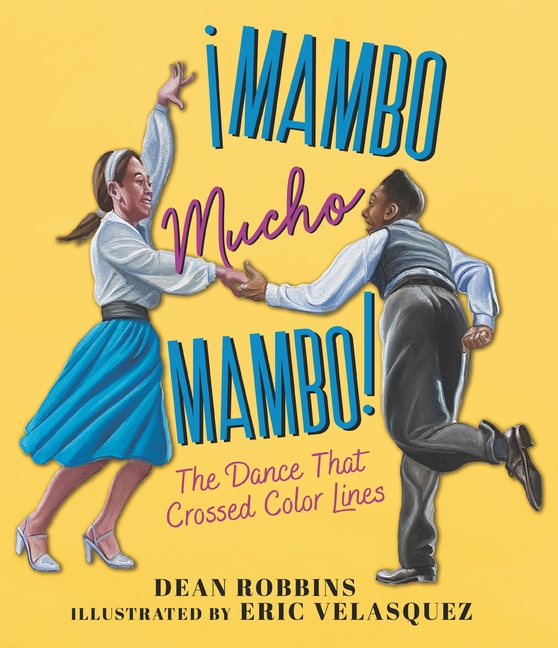Illustrated by Eric Velasquez (Candlewick, November 23, 2021)
In 1940s New York City, people from different backgrounds aren’t allowed to dance in the same places. But then the Palladium Ballroom opens its doors so everyone can enjoy a thrilling new sound called Latin jazz and a bold new dance called the mambo. When two young dancers meet on the Palladium’s dance floor, their cross-cultural partnership helps spark the civil rights movement that will tear down barriers across the country.
HONORS
New York Public Library Best Books of the Year
Chicago Public Library Best Books of the Year
Chicago Public Library Best Books of the Year in Spanish
Bank Street College of Education Best Children’s Books of the Year
Junior Library Guild Gold Standard Selection
Jane Addams Children’s Book Award finalist
Association for Library Service to Children Notable Books List
Children’s Book Council’s Notable Social Studies Trade Books
Texas Topaz Nonfiction Reading List
PRESS
Milwaukee Journal Sentinel interview
St. Louis Post-Dispatch interview
Wisconsin Public Radio interview
Wisconsin State Journal interview
TeachingBooks Virtual Author Tour
St. Paul Pioneer Press article
St. Louis Jewish Light interview
PURCHASE
¡Mambo mucho mambo!: El baile que atravesó la barrera del color (Spanish edition)
RESOURCES
Candlewick Press teachers’ guide
REVIEWS
Starred review: Dean Robbins’s snappy language and smoking turn of phrase bring the mambo and all its followers to life. Eric Velasquez’s illustrations send sparks flying off each full-bleed spread. There’s nothing static in these dynamic, full-movement portrayals of humans expressing the unadulterated joy of popping music and uninhibited dancing. Fiery and rhythmic storytelling surges to the beat of the conga—a must-have selection for all ages.
— School Library Journal
Starred review: Young readers will be pulled into 1940s New York, a time of segregation where it was frowned upon for people from different neighborhoods and cultures to mingle. But something exciting was happening in the city: a new music style blending Latin and jazz was being born, with lively, vibrant tunes that sent a thrill through listeners, encouraging them to dance. Realistic illustrations with historical details bring to life the many moves and twirls dance couples enjoyed in close-up views.
— Booklist
Dean Robbins’s prose is as musical as his subject. Eric Velasquez’s characteristic, near-photorealistic illustrations, rendered in oil paint in a palette reflecting the time, add a dynamic fluidity to the historical atmosphere of this enlightening narrative nonfiction title.
— Publishers Weekly
Dynamic text goes hand in hand with vibrant, motion-filled illustrations to tell the story of the Latin sound that swept through New York and then the country in the 1940s and ’50s.
— Kirkus Reviews
We open on the streets of New York with an introduction to Millie Donay and Pedro Aguilar in action, their dance moves exploding off the pages in energetic, realistic oils. In Dean Robbins’ and Eric Velasquez’s hands, this early challenge to segregation makes for a lively, compelling piece of history.
— The Horn Book
As the dancers on each page of “Mambo Mucho Mambo” swing and sway, the smart text paints a clear picture of New York City’s love of music and dancing — and the segregation that kept those dancers apart. But when the groundbreaking band Machito and His Afro-Cubans start playing Latin jazz, it’s a hit, and people from all over the city come together to dance at the Palladium Ballroom, in defiance of those rules. The illustrations follow the mambo moves of Millie and Pedro — a real-life couple, Italian and Puerto Rican, who “showed the world that anyone, anytime, can dance together.”
— The Virginian-Pilot
If the words don’t have you dancing, the illustrations will have you leaping up and moving wherever you are. The images bring the people, places, and time to you with vibrancy and luminosity.
— Librarian’s Quest
This is a good introduction to the idea of small acts by individuals contributing to larger social change. The musicians and dancers used their talents and creative abilities to express themselves; this in turn helped to desegregate New York and promote the idea of racial equality. Realistic illustrations feature many images of dancers along with descriptive language that captures the energy of the music.
— Youth Services Book Review
